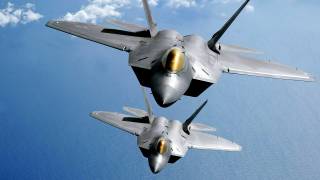US Preparing to Put Nuclear Bombers Back on 24-Hour Alert
If the order comes, the B-52s will return to a ready-to-fly posture not seen since the Cold War
The U.S. Air Force is preparing to put nuclear-armed bombers back on 24-hour ready alert, a status not seen since the Cold War ended in 1991.
That means the long-dormant concrete pads at the ends of this base’s 11,000-foot runway — dubbed the “Christmas tree” for their angular markings — could once again find several B-52s parked on them, laden with nuclear weapons and set to take off at a moment’s notice.
“This is yet one more step in ensuring that we’re prepared,” Gen. David Goldfein, Air Force chief of staff, said in an interview during his six-day tour of Barksdale and other U.S. Air Force bases that support the nuclear mission. “I look at it more as not planning for any specific event, but more for the reality of the global situation we find ourselves in and how we ensure we’re prepared going forward.”
Goldfein and other senior defense officials stressed that the alert order had not been given, but that preparations were under way in anticipation that it might come. That decision would be made by Gen. John Hyten, the commander of U.S. Strategic Command, or Gen. Lori Robinson, the head of U.S. Northern Command. STRATCOM is in charge of the military’s nuclear forces and NORTHCOM is in charge of defending North America.
Putting the B-52s back on alert is just one of many decisions facing the Air Force as the U.S. military responds to a changing geopolitical environment that includes North Korea’s rapidly advancing nuclear arsenal, President Trump’s confrontational approach to Pyongyang, and Russia’s increasingly potent and active armed forces.
Goldfein, who is the Air Force’s top officer and a member of the Joint Chiefs of Staff, is asking his force to think about new ways that nuclear weapons could be used for deterrence, or even combat.
“The world is a dangerous place and we’ve got folks that are talking openly about use of nuclear weapons,” he said. “It’s no longer a bipolar world where it’s just us and the Soviet Union. We’ve got other players out there who have nuclear capability. It’s never been more important to make sure that we get this mission right.”
During his trip across the country last week, Goldfein encouraged airmen to think beyond Cold War uses for ICBMs, bombers and nuclear cruise missiles.
“I’ve challenged…Air Force Global Strike Command to help lead the dialog, help with this discussion about ‘What does conventional conflict look like with a nuclear element?’ and ‘Do we respond as a global force if that were to occur?’ and ‘What are the options?’” he said. “How do we think about it — how do we think about deterrence in that environment?”
Asked if placing B-52s back on alert — as they were for decades — would help with deterrence, Goldfein said it’s hard to say.
“Really it depends on who, what kind of behavior are we talking about, and whether they’re paying attention to our readiness status,” he said.
Already, various improvements have been made to prepare Barksdale — home to the 2d Bomb Wing and Air Force Global Strike Command, which oversees the service’s nuclear forces — to return B-52s to an alert posture. Near the alert pads, an old concrete building — where B-52 crews during the Cold War would sleep, ready to run to their aircraft and take off at a moment’s notice — is being renovated.
Inside, beds are being installed for more than 100 crew members, more than enough room for the crews that would man bombers positioned on the nine alert pads outside. There’s a recreation room, with a pool table, TVs and a shuffleboard table. Large paintings of the patches for each squadron at Barksdale adorn the walls of a large stairway.
One painting — a symbol of the Cold War — depicts a silhouette of a B-52 with the words “Peace The Old Fashioned Way,” written underneath. At the bottom of the stairwell, there is a Strategic Air Command logo, yet another reminder of the Cold War days when American B-52s sat at the ready on the runway outside.
Those long-empty B-52 parking spaces will soon get visits by two nuclear command planes, the E-4B Nightwatch and E-6B Mercury, both which will occasionally sit alert there. During a nuclear war, the planes would become the flying command posts of the defense secretary and STRATCOM commander, respectively. If a strike order is given by the president, the planes would be used to transmit launch codes to bombers, ICBMs and submarines. At least one of the four nuclear-hardened E-4Bs — formally called the National Airborne Operations Center, but commonly known as the Doomsday Plane — is always on 24-hour alert.
Barksdale and other bases with nuclear bombers are preparing to build storage facilities for a new nuclear cruise missile that is under development. During his trip, Goldfein received updates on the preliminary work for a proposed replacement for the 400-plus Minuteman III intercontinental ballistic missiles, and the new long-range cruise missile.
“Our job is options,” Goldfein said. “We provide best military advice and options for the commander in chief and the secretary of defense. Should the STRATCOM commander require or the NORTHCOM commander require us to [be on] a higher state of readiness to defend the homeland, then we have to have a place to put those forces.”






















